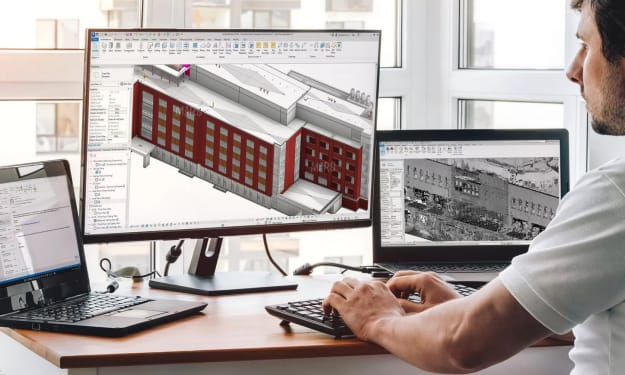
The Scan to BIM workflow is revolutionizing the AEC (Architecture, Engineering, and Construction) industry by seamlessly converting real-world data into intelligent BIM. This empowers stakeholders with a powerful and accurate digital representation of a building or site, fostering better collaboration, informed decision-making, and improved project outcomes.
Understanding the Process Scan to BIM involves a series of well-defined steps:
- Project Planning: Clearly define the project goals and identify the information required from the BIM model. This ensures the scanning process captures the necessary details.
- Scan Planning and Field Execution: Plan the scanning strategy considering factors like laser scanner type, required level of detail, and site accessibility. Utilize skilled professionals to perform the scan, ensuring comprehensive capture of the entire space.
- Data Processing: The raw scan data, often in the form of a point cloud (a dense collection of data points representing the building's geometry), undergoes registration and cleaning. Registration aligns multiple scans to create a unified point cloud, while cleaning removes noise and extraneous data.
- Modeling: Using specialized software, the processed point cloud is converted into a BIM model. This involves creating intelligent building elements (walls, doors, windows, etc.) with associated data like dimensions, materials, and properties. The level of detail in the model corresponds to the project requirements.
- Quality Control: The final BIM model undergoes rigorous quality checks to ensure accuracy and completeness. This may involve clash detection (identifying conflicts between building elements) and verification with the original scan data.
Benefits of Scan to BIM
- Enhanced Accuracy: Scanned data provides a highly accurate representation of existing conditions, minimizing errors and rework throughout the project lifecycle.
- Improved Efficiency: BIM models streamline workflows for design, construction, and facilities management, leading to significant time and cost savings.
- Better Collaboration: A shared BIM model facilitates communication and collaboration between project stakeholders, fostering transparency and informed decision-making.
- Reduced Risk: Identifying potential issues like clashes early in the design phase helps mitigate risks and costly onsite corrections.
- Facility Management: BIM models can be used for ongoing facility management, enabling efficient space utilization, maintenance scheduling, and asset tracking.
Applications of Scan to BIM
- Renovations and Retrofits: Existing building data captured through scanning allows for accurate modeling and facilitates informed design decisions for renovations or additions.
- Historic Preservation: Scanned data can be used to document and preserve historic buildings, enabling accurate restoration and future maintenance plans.
- Construction Site Monitoring: Regular scans can track construction progress, identify deviations from the plan, and facilitate better quality control.
- Facility Management: BIM models created from scans provide a valuable tool for managing existing buildings, optimizing space utilization, and streamlining maintenance operations.
The Future of Scan to BIM
As technology advances, Scan to BIM workflows will become even more sophisticated and integrated. We can expect:
- Automation: Increased automation in data processing and modeling will streamline the workflow and improve efficiency.
- Real-Time Scanning: Integration with real-time scanning technologies will enable continuous monitoring of construction progress and dynamic BIM model updates.
- Advanced Analytics: BIM models enriched with scan data will provide valuable insights for facility management and performance optimization.
By harnessing the power of Scan to BIM, AEC professionals can create intelligent and data-rich building models that contribute to a more efficient, collaborative, and sustainable built environment.
About the Creator
Zara
Hello, I am Zara Anderson,I work as a MaRS Trans USA LLC Company Business Development executive, mostly in the US delivering value to global locations. I'm assisting the conventional AEC business with the use of Scan to BIM Services.






Comments
There are no comments for this story
Be the first to respond and start the conversation.